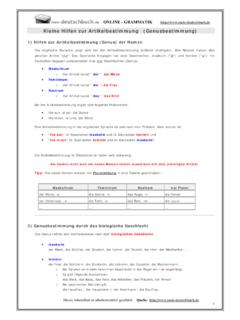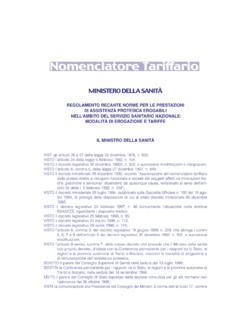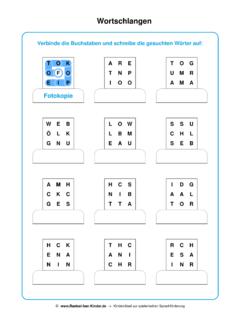Transcription of What´s your name, sugar ? A simple abbreviation …
1 What s your name, sugar ? a simple abbreviation system for complex N-glycan structures It all starts with the common pentasacharide core, which we tenderly call MM. MM =. For anything addded to this foundation stone, we only write what is minimally needed to umambigously annotate the structure. Only the terminal residues are given beginning with that on the upper , 6-linked antenna, then the 3-linked antenna and then substituents to the core. Examples of N-glycans from human IgG and bovine fibrin, respectively, are shown below. The colours are only for the sake of legibility.
2 4 6. GnA F. (sloppy: GnAF). 6-4 3-3. Na Na (= Na6-4Na3-3). Version 5-10. 2. Introduction How shall cell biologists, immunologists, hematologists, biotechnologists and other normal . scientists ever deal with protein glycosylation when even glycobiologists themselves cannot find practicable names for the compounds they are working with? We are either dealing with monsters of chemical formulas such as: -Neup5Ac-(2 6)- -D-Galp-(1 4)- -D-GlcpNAc-(1 2)- -D-Manp-(1 6)- { -Neup5Ac- (2 3)- -D-Galp-(1 4)-D-GlcpNAc-( 1 4)- [ -Neup5Ac-(2 6)- -D-Galp-(1 4)- -D- GlcpNAc-(1 2)] - -D-Manp-(1 3)} - -D-Manp-(1 4)- -D-GlcpNAc-(1 4)-D-GlcpNAc-, or we make use of IUPAC s offer [1, 2] to write the same glycan this way: Neu5Ac 2-6 Gal 1-4 GlcNAc 1-2 Man 1-6 [Neu5Ac 2-3 Gal 1-4 GlcNAc 1-4 (Neu5Ac 2- 6 Gal 1-4 GlcNAc 1-2)Man 1-3] Man 1-4 GlcNAc 1-4 GlcNAc.
3 Knowing that there is just one option for a the glycosidic linkage on the left side, redundancy can still be reduced: Neu5Ac -6 Gal -4 GlcNAc -2 Man -6 [Neu5Ac -3 Gal -4 GlcNAc -4 (Neu5Ac -6 Gal - 4 GlcNAc -2) Man -3] Man -4 GlcNAc -4 GlcNAc;. Alternatively, the elements of the formula can be colored to facilitate apprehension as on the homepage of the Consortium of Functional Glycomics ( ). Neu5Ac a2-6 Gal b1-4 GlcNAc b1-2 Man a1-6 [NeuAc a2-3 Gal b1-4 GlcNAc b1-2. (Neu5Ac a2-6 Gal b1-4 GlcNAc b1-2) Man a1-3] Man b1-4 GlcNAc b1-4 GlcNAc.
4 It is by far easier to understand the semi-graphical representation shown in Fig. 1A. Graphical depictions with symbols certainly help percepting the overall architecture of a glycan. In the Oxford system the cartoons even transport all the linkage information in a consistent, easily decipherable way [3]. Nevertheless, it requires a graphic program and one soon encounters steric hindrances a in the example structure shown above. In other words, cartoons and graphics are time consuming and space wasting. Many abbreviations have been used but we feel that this systems lacked the ability of describing N-glycans precisely and still in a compact form.
5 The term GlcNAc2 Man3 GlcNAc3 Gal3 Neu5Ac3 - application of another widely used way to fight the naming problem - fails to provide any information about linkages of the galactoses or sialic acids. Here we will learn to fully 6-4 3-4 6-4. describe the above glycan with the term Na [Na Na ]. 3. Fig. 1: Graphical depictions of a triantennary N-glycan. A) Most compact format allowed by IUPAC;. B) LINUC code used by the Glycosciences Database C) Symbolic depiction used by Kole et al. 2];. D) or by Butler et al. [3];. E) cartoon style of the Consortium of Functional Glycomics Consortium (CFG).
6 F) linkage-sensitive CFG-plus cartoons (the best mode in our opinion). A) Neu5Ac 6 Gal 4 GlcNAc 2 Man . 6. Neu5Ac 3 Gal 4 GlcNAc Ma n 4 GlcNAc 4 GlcNAc 4 3. Neu5Ac 6 Gal 4 GlcNAc 2 Man . B). a-D-Neup5Ac-(2-6)-b-D-Galp-(1-4)-b-D-Glc pNAc-(1-2)-a-D-Manp-(1-6)+. |. a-D-Neup5Ac-(2-3)-b-D-Galp-(1-4)-b-D-Glc pNAc-(1-4)+ b-D-Manp-(1-4)-b-D-GlcpNAc-(1-4)-D-GlcNA c | |. a-D-Manp-(1-3)+. |. a-D-Neup5Ac-(2-6)-b-D-Galp-(1-4)-b-D-Glc pNAc-(1-2)+. C) D). 6 4 2. 6. E) 3 4 4 F) 6. 4 4 3 4 1. 2 3 2. 6 4. 4. The single letter code Recently, a single letter code for sugar units has been proposed [1].
7 We will use this code with minor modifications which enable us to discriminate between N-acetyl- and N-glycolyl- neuraminic acid and which retain the root symbol of the hexose in uronic acids. The sugars occurring in mammalian N-glycans are abbreviated in this way: G glucose; A galactose;. M mannose; F fucose;. X xylose; Gn N-acetylglucosamine;. An N-acetylgalactosamine; Gu glucuronic acid;. Na N-acetylneuraminic acid; Ng N-glycolylneuraminic acid;. For non-carbohydrate substituents these symbols are proposed: acetate ac; sulphate su; phosphate ph; methyl me.
8 The basic rules of the proglycan system Rule 1: The terminal residues are given. Rule 2: The residues are listed in counter clockwise direction so that the order is: the first place gives the 6-antenna, the second place the 3-antenna, and the third place lists the substituents to the core (fucose linked to GlcNAc-1, Xyl or bisecting GlcNAc linked to Man- 3). Rule 3: The linkage of a sugar is specified by a superscript (for reasons of legibility; not obligatory). 5 4 . GlcNAc 2 Man Fuc . Fig. 2: Example of the 6 6. 3. translation of an N-glycan 3 2 1.
9 Gal 4 GlcNAc 2 Man . structure into the proglycan code. 7 6 4. In the glycan shown in Fig. 2 (same as in abstract) the terminal residue on the upper antenna is a GlcNAc and hence our formula starts with Gn. The lower antenna ends with a galactose and thus the second position of the abbreviation is an A leading to GnA. To denote the presence of a fucose linked to the chitobiose we now add an F so that we now have GnAF. (or, in this tutorial, GnAF to emphasize the three positions of the formula). While the term GnAF may already be useful for many purposes this degenerate code is ambiguous as there is also 1,3-linked galactose (in mammals; type I chain ) and 1,3- 5.
10 Linked fucose in insect or plants. For an exact representation of the structure, superscripts 4 6 4 6. are used and the above glycan has the correct name GnA F (or GnA F ). One advantage of this annotation is its inherent ability to identify branch isomers. The isomer 4 6 4 6. of GnA F where the galactose is linked to the upper arm has the name A GnF (exact code). or AGnF (degenerate code). Plant glycoproteins carry N-glycans with a xylose 1,2-linked to the -mannose of the core. 3. There is no other xylose linkage known and so we can write GnGnXF (or tutorial: 3.)






